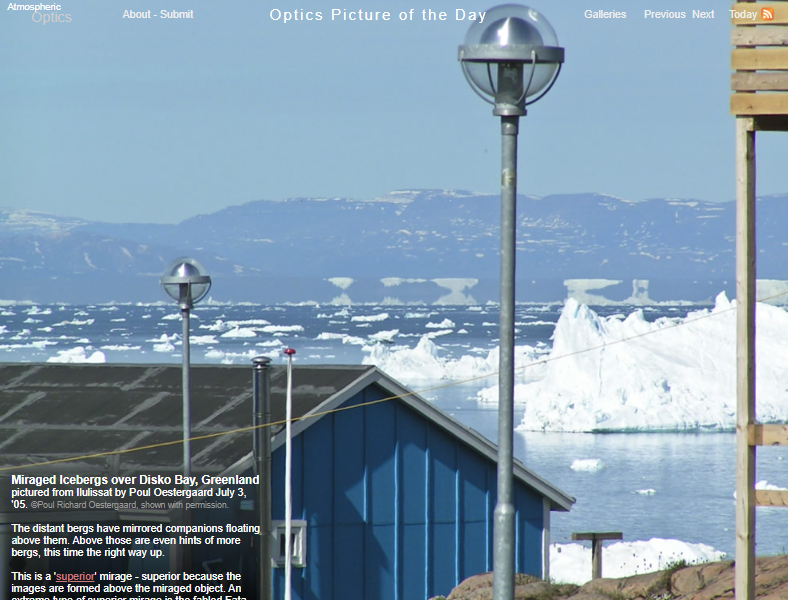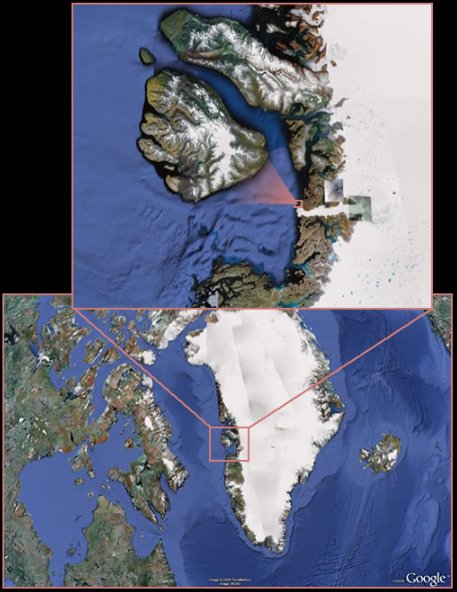Miraged Icebergs, Greenland
Miraged Icebergs: A Spectacular Phenomenon in Greenland
Greenland, with its breathtaking landscapes and icy wonders, offers a unique spectacle to those fortunate enough to witness it. One such phenomenon is the miraging of icebergs, which creates a mesmerizing optical illusion in the skies above Disko Bay. This natural marvel, captured by Poul Richard Oestergaard in July 2005, showcases the beauty and complexity of atmospheric optics.
In this extraordinary image, the distant icebergs are accompanied by their mirrored counterparts floating above them. But that's not all; there are even hints of additional icebergs appearing in the right orientation. This captivating spectacle is known as a "superior" mirage, where the images appear above the actual objects being mirrored.
To understand this phenomenon, we need to delve into the concept of temperature inversions. When the frigid waters of the sea come into contact with the air, they cool it down. This creates a layer of cold air beneath the warmer air. When observed against the backdrop of mountains located 50-90 kilometers away, this cold air appears as a dark band.
The magic of miraged icebergs lies in the refraction of light rays passing through the boundary between the denser, colder air and the warmer air above it. As these rays traverse this boundary, they curve and become concave towards the horizon. The curvature is strongest where there is a significant difference in temperature between the layers of air.
In the diagram provided, we can see that the ray originating from the top of the real iceberg (ray 'b') is slightly curved, making it appear as though it originates from a point above its actual position. On the other hand, ray 'c,' which originates from the base of the iceberg, encounters an even greater temperature gradient and is refracted more strongly. According to a general rule, when rays intersect, the resulting image is inverted. Hence, an upside-down iceberg appears to float above the real one.
However, when the inversion layer is thick enough, rays from the top of the iceberg (ray 'd') can take a different route through the upper, warmer air before curving downward towards the observer or camera. This creates a third image of the iceberg, this time in the correct orientation. In the photograph, we can observe traces of this right-side-up image where the base of the iceberg starts to bulge upwards.
The occurrence of miraged icebergs in Greenland has historical significance as well. It is believed that Erik the Red, the Norse explorer, visited this area around 980 AD. Moreover, many early polar expeditions made their final stop here before embarking on treacherous journeys in search of the elusive Northwest Passage.
The miraging of icebergs in Greenland is a testament to the intricate interplay between temperature inversions and light refraction. This natural phenomenon showcases the wonders of atmospheric optics and captivates the imagination of all who have the privilege of witnessing it. As we continue to explore and understand the complexities of our planet's atmosphere, phenomena like these remind us of the awe-inspiring beauty that surrounds us.

Miraged Icebergs over Disko Bay, Greenland pictured from Ilulissat by Poul Oestergaard July 3, '05. ©Poul Richard Oestergaard, shown with permission.
The distant bergs have mirrored companions floating above them. Above those are even hints of more bergs, this time the right way up.
This is a 'superior' mirage - superior because the images are formed above the miraged object. An extreme type of superior mirage is the fabled Fata Morgana (1,2,3). Everyday 'inferior' or hot road mirages have the image below the object creating them.
A temperature inversion is responsible. The icy cold sea cools the air it is in contact with forming an unusually cold layer beneath warmer air. The cold air is visible against the 50-90 km distant mountains as a dark band.
Light rays passing between the dense colder air and the upper warm air are refracted. The ray paths become curved and concave to the horizon level. I.e. they tend to curve downward. The curvature is always such that the rays tend to curve towards the cooler - denser - air. The ray curvature is strongest where the vertical temperature gradient is greatest.

In the diagram at right the ray 'b' from the real berg top is slightly curved making it appear to originate from a point above. Ray 'c' from the berg's base encounters a higher region of even greater temperature gradient and is more strongly refracted. A rule of thumb is that where ray crossing occurs the resulting image is inverted. An upside down berg floats over the lower one.
When the inversion layer is thick enough, rays from the berg top have a third route 'd' available through upper warmer air before curving down towards the eye or camera. They form a third image - this time the right way up. Traces of it show in the picture where the berg base starts to bulge upwards.
Erik the Red is said to have visited the area in c.980. It was also the final call for many early polar expeditions before they quickly got themselves icebound while searching for the North West Passage.

Note: this article has been automatically converted from the old site and may not appear as intended. You can find the original article here.
Reference Atmospheric Optics
If you use any of the definitions, information, or data presented on Atmospheric Optics, please copy the link or reference below to properly credit us as the reference source. Thank you!
-
<a href="https://atoptics.co.uk/blog/miraged-icebergs-greenland/">Miraged Icebergs, Greenland</a>
-
"Miraged Icebergs, Greenland". Atmospheric Optics. Accessed on November 26, 2024. https://atoptics.co.uk/blog/miraged-icebergs-greenland/.
-
"Miraged Icebergs, Greenland". Atmospheric Optics, https://atoptics.co.uk/blog/miraged-icebergs-greenland/. Accessed 26 November, 2024
-
Miraged Icebergs, Greenland. Atmospheric Optics. Retrieved from https://atoptics.co.uk/blog/miraged-icebergs-greenland/.